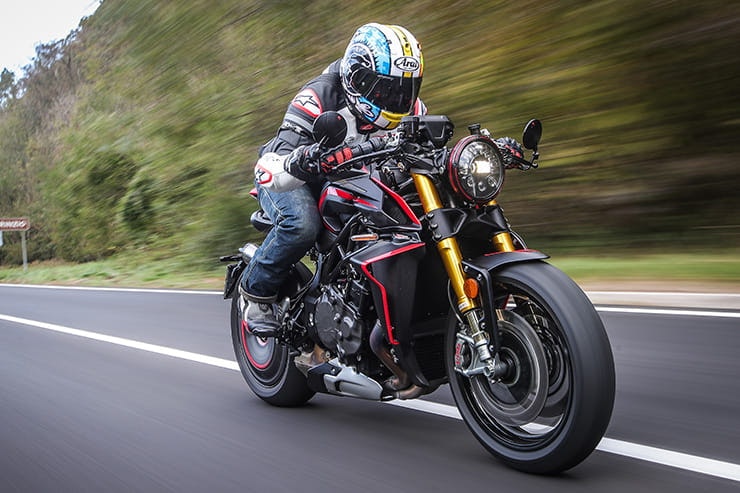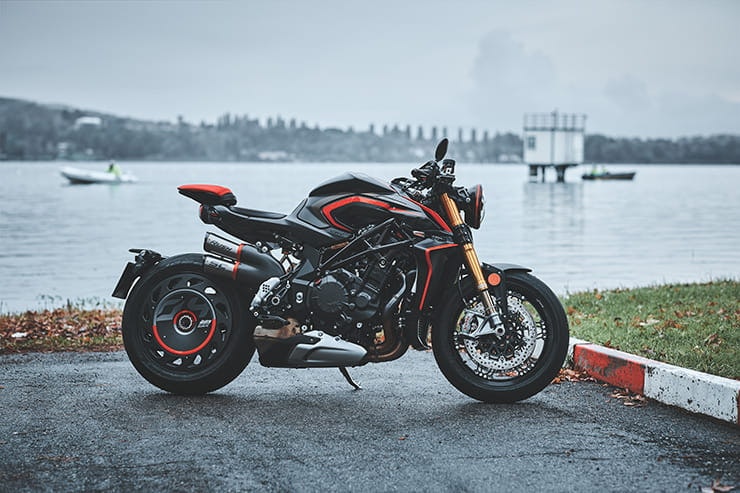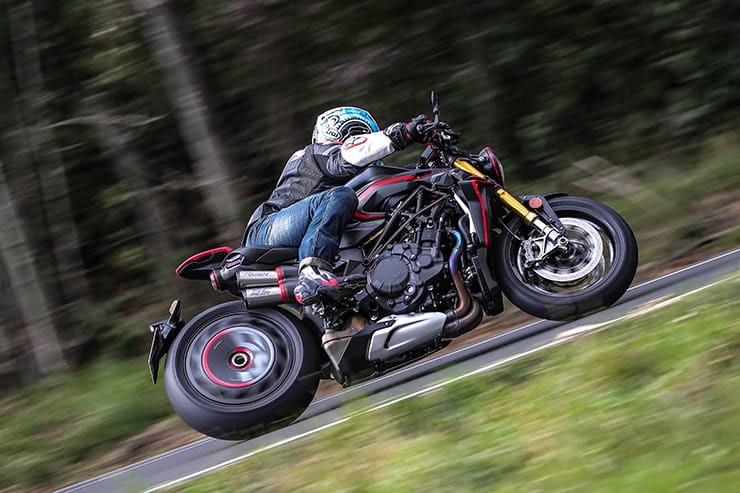MV Agusta Rush 1000 (2020) - Review
BikeSocial Road Tester
26.10.2020
When I was 17, I had three posters on my wall: a white Lamborghini Countach, Pamela Anderson in a swimsuit, and a Britten motorcycle. If I were 17 again I’d add a poster of the MV Agusta Rush 1000 to my collection because this is the poster bike of 2020… assuming 17-year-olds still have posters. Maybe it’s the screensaver of 2020. Either way, the Rush is a stunning bike and when it was unveiled at EICMA in November 2019 jaws, ok dribble, hit the floor.
The Rush is a limited edition run of 300 units of the already highly acclaimed MV Brutale 1000RR. And when your base bike is already hugely desirable you’re not going to be far off the mark with the special, in fact it’s a bit like giving a supermodel a makeover. From every angle it’s striking; the huge carbon-enclosed rear wheel, adaptive cornering headlight, restyled rear end and small pillion seat, even a neat plate by the ignition switch to remind you which of the 300 bikes you have – and enough carbon to rival an F1 car. But as you’d expect the Rush isn’t a cheap date and is priced at £31,890 with the race kit (homologated exhaust and fuelling), and £29,290 in standard form with four protruding exhausts like those on the 1000RR.
But don’t be fooled, this isn’t just a show bike – even with the race exhaust it’s still homologated for Euro 4. And the titanium rodded engine will produce 209bhp at 13,000rpm in this format. That is race winning performance in a naked, carbon clad and sexy chassis.
We headed to Varese, the home of MV in northern Italy, to put this new and powerful bike through its paces.
Image, looks, appeal and exclusivity
Engine performance at high revs
Crisp sound
Price alienates many
Comfort isn’t the best
There’ll only ever be 300
2020 MV Agusta Rush 1000 Price
£31,890 as tested (£29,290 standard)
It’s a limited edition run of just 300 bikes sold world-wide but, at over 30k, is plenty of money, though I’m sure the price will be a drop in the ocean for some collectors and enthusiasts. There is a good chance the Rush won’t depreciate and more than likely become a target for collectors, while I doubt you’ll see a Rush being ridden in anything but perfect road conditions. The standard MV Brutale 1000RR is £27,290, which means you’re only paying £2000 for the limited-edition Rush. That makes it a bargain, doesn’t it? For reference, the race kit is an extra £2600.
The Rush is on par with other exclusive models like Ducati’s Panigale V4R (£34,995) and Ducati’s 25 Anniversario 916 Panigale V4 (£36,995). Interestingly, Aprilia’s track-only Tuono V4X is expected to be €34,900 leaving the new MV Rush 1000 as not the most expensive naked bike on the market.
Power and torque
209bhp from a normally-aspirated 1000cc engine would, just a decade ago, have been the preserve of fragile, race-winning superbikes, not a road-going engine with normal service intervals. It’s more powerful than most 1000cc nakeds and outguns dedicated sports bikes like Kawasaki’s ZX-10, Yamaha’s R1, and Suzuki’s GSX-R1000.
As you’d expect, peak power and torque are high up in the rev range, with 86ftlb of torque made at 11,000rpm as the peak figure. The race kit, which consists of the homologated exhaust and different ECU, pushes peak power up to 209bhp from 205bhp, and torque is smoother with a 3% increase. There is an additional track-only exhaust system that pushes power even higher and will be available shortly… watch this space!
The screaming inline four-cylinder engine is the same as that found in the MV Brutale 1000RR. To achieve the impressive performance figures MV has introduced titanium conrods, which allow the engine to spin faster and to higher rpm. There are also new valve guides and camshafts, which allow new timings on both the exhaust and intake valves. Lubrication has been improved, and the amount of oil needed for the engine has been reduced.
The powerplant now breathes via a new air-box which is fed from longer air-intakes. On the standard model, the tuned engine releases its gases via a gorgeous four-into-one-into-four exhaust system which is made in partnership with Arrow. However, the race kit version benefits from just two exiting exhausts. There’s new ride-by-wire fuelling with double injectors and four rider modes (Sport, Race, Rain and Custom).
Engine gearbox and exhaust
The standard MV Brutale 1000RR sounds fantastic, but now with the race exhaust, it’s taken to another level. If the standard bike is Pavarotti, then the Rush with race exhaust is The Three Tenors plus a full live orchestra. At low revs, blipping the quick-revving engine gives a charismatic growl and a tantalising indication of what is to come.
Higher in the rev range is an overload of the senses. North of Varese, up into the mountains, and each long tunnel was a cacophony of noise as I quickly fed it gears that allowed the engine to scream. Thrashing a sweet-sounding MV through kilometre-long tunnels is highly addictive.
You’ll love the sound of the Rush, and with peak power at an eye-watering 13,000rpm, you’ll find yourself constantly revving this Italian beauty. It loves to rev, and it feels like there is little mechanical friction as the revs rise so rapidly. The clutchless quick-shifter is effortless, and smooth revs perfectly match each gear change. In the hills it’s hard to ride slowly, as each time you see the road open up you tap back a few gears and are propelled forward at an alarming rate accompanied by that lovely chorus from the race pipe.
This all sounds wonderful and romantic, whipping a £30k MV in the heart of the Italian countryside, but the downside is that in the real world there is little go below 6000rpm. In fact, the party only really gets going above 80000rpm.
The Rush will certainly pull cleanly from low rpm, and the fuelling is smooth, especially in the Rain mode, but it feels hesitant. Once or twice I attempted to overtake slow-moving traffic in 5th and 6th gear, and the engine felt breathless low down in the power. It’s not slow, over 200bhp is never going to be that, and there isn’t a massive kick of power in the midrange to worry about either, but like the 1000RR the Rush almost has two personalities.
Below 8000rpm it’s mild and will go home early on a school night but anything north of that, especially over 10,000rpm, it wants to throw a TV out of a hotel window and drive a Rolls-Royce into a swimming pool.
You could argue that no-one who buys an MV Rush will want to ride it around town, aside from posers like myself, of course, so what does it matter? And, from experience, I know the 1000RR works on the track, and I can see the same conclusion of the new Rush. MV quotes a top speed of over 300kph and, with 209bhp, I can see that. In the final third of the revs, the Rush just keeps on accelerating like a race bike. The semi-dropped café racer bars would make this speed almost bearable, and I’d love to try one on track. But I’m guessing very few of the 300 will ever see Mugello or Imola.
Economy
Will Rush owners consider fuel economy? I guess they will if they ever run out of fuel. As the new MV is Euro4 homologated, MV quote 6.7l/1000km, or around 42mpg. With a 16-litre fuel tank, you’re looking at 140 miles per tank before panic sets in. Dependent on how you ride, your weight and style, I’d estimate you could push consumption to over 50mpg on a steady run, and closer to 30mpg on track. MV has fitted cruise control, which takes the pain out of long motorway journeys.
Handling, suspension, chassis and weight
The Rush runs Öhlins semi-active suspension front and rear with each riding mode changing the action of the electronic suspension (Rain is softer than Race, for example). We only managed to ride the Rush on the road, mainly in its natural habitat – mountains – and on the fast-flowing sections it’s hard to fault. It feels like a race bike with the bodywork removed, while the café racer riding position allows you to attack corners with confidence, and the huge rear 200 section Pirelli finds endless grip.
The taught suspension copes with everything you can throw at it, at times while riding in protective jeans, I had to lift up my knee to avoid it touching. You sit more in the bike than on, out of the wind, and it’s less physical than most naked bikes. Everything works: peg position, rear seat hump… you can really tuck in, carrying enormous corner speed with no fear of understeer like some naked bikes which push the front. The sporty handling will transfer on track, despite its glamourous looks the Rush will be more than capable of holding onto a sports bike on a track day, and even embarrass a few with superior power.
There is an addictive lean angle and G-Force display on the full colour dash. You can check your lean angle mid-corner with a quick glance, or see the G-Force as you accelerate hard. Unnecesaary yet entertaining for a shortwhile nonetheless. The clocks are excellent and even change colour as you enter tunnels as they react to a lower light level, but they are a little hard to see when the sunlight is directly behind you.
However, there is a flip side to the race bike handling. Even in Rain mode, the suspension is harsh when the road isn’t race track-smooth, especially at slower speeds around town over road imperfections like cobbles, potholes and speed humps. It’s not like riding a skateboard over cobbles, it’s not agony, but with such sophisticated suspension I would expect the ride to be a little plusher in the Sport and Rain modes.
A relatively thin site exaggerates this feeling further. It’s simple to change the suspension and, if it was my bike I’d quicky change the Öhlins to allow a softer ride on the road, which would make the ride comfier for motorway cruising for rider and pillion. Speaking of which, the pillion is going to have to be tiny and brave, but to be honest, they only upset the handing, so give them the money to catch a cab.
2020 MV Agusta Rush 1000 Brakes
On the road, you shouldn’t really be pushing the huge Brembo Stylema radial stoppers to their limit, and after our test ride there were no complaints. The corning ABS is welcome support, and on the road isn’t intrusive. One finger on the span adjustable lever is enough to stop the rev-happy fun. Again, like the rest of the bike, the stoppers are race bike spec, you really don’t need anymore. I know from experience the Bosch ABS system can be a little intrusive on slick tyres when pushing for lap times on the track, but if you’re fitting race tyres and pushing for fast laps on the Rush, then you’ve bought the wrong bike.
Rider aids and extra equipment/accessories
As you’d expect from a £30,000 naked superbike, it’s dripping with rider aids and the very latest technology and, furthermore, via the full-colour clocks, they are easy to use and navigate. The rider aids are clearly shown by a bike illustration on the right side. A 6-axis IMU is the brains behind everything which means both traction control and ABS braking are lean sensitive. There are eight levels of TC, which can also be de-activated, again via the dash or your phone on the MV app. It’s simple and easy to do and clearly shown on the dash. A real plus point is the dash/bike remembers your last setting when you reduce the traction control, so you don’t have to re-set your traction every time you ride.
MV call its anti-wheelie front lift control, and this is either on or off, there aren’t multiple settings unlike most other bikes in this category. The idea is that the lift control limits the engine’s torque, which reduces the acceleration slightly to control the front wheel lift. The front will still hover above the ground, but you’re still accelerating hard, not cutting the power with the front end dramatically dropping and reintroducing again – the pogo effect some machines have as their electronics try to control the wheelie. There is also launch control as standard, plus that up-and-down quick-shifter and cruise control on the right bar.
The rider aids are excellent, you don’t ‘feel’ the systems working. They are there to keep you safe, allow you to ride to the conditions and your style and skill. The switchgear and clear dash make it easy to flick between modes, even turn off the traction and front-wheel lift on the move for some wheelie fun, which, of course, this 209bhp machine does effortlessly.
Rivals
2020 MV Agusta Rush 1000 Verdict
The new MV Rush is double the price of KTM’s Super Duke R, or £10,000 more than a Ducati Streetfighter V4S and has similar performance and spec as the Ducati. But if you’re looking at the price tag, then you’re looking at the wrong bike. This is the Lamborghini or Ferrari of the bike world, price is almost insignificant, it’s how the bike performs, sounds, looks, and ultimately how it makes you feel.
Riding in the hills north of Varese, letting the engine scream through the hand-cut tunnels that bore through the mountain, hitting the passes and sweeping bends is paradise. This is the bike James Bond should be riding, it sounds and looks fantastic, and handles like a race bike with no bodywork. Yes, it’s not very comfortable, the suspension is harsh around town, and there are a few niggles like reflections in the dash. But you don’t buy a Ferrari because it’s comfortable and has good boot space, and I don’t think anyone has ever complained their Lamborghini passenger comfort. If you’re looking at the price tag, fuel economy, and comfort, walk away, this is a bike you own because you love it.
2020 MV Agusta Rush 1000 Technical Specification
Looking for bike insurance? Get a quote for this motorcycle with Bennetts motorbike insurance
Photography by Miagro
What is MCIA Secured?
MCIA Secured gives bike buyers the chance to see just how much work a manufacturer has put into making their new investment as resistant to theft as possible.
As we all know, the more security you use, the less chance there is of your bike being stolen. In fact, based on research by Bennetts, using a disc lock makes your machine three times less likely to be stolen, while heavy duty kit can make it less likely to be stolen than a car. For reviews of the best security products, click here.
MCIA Secured gives motorcycles a rating out of five stars, based on the following being fitted to a new bike as standard:
A steering lock that meets the UNECE 62 standard
An ignition immobiliser system
A vehicle marking system
An alarm system
A vehicle tracking system with subscription
The higher the star rating, the better the security, so always ask your dealer what rating your bike has, and compare it to other machines on your shortlist.


